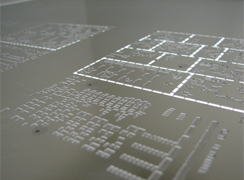Dear valued customer:
Welcome to our new website. It will be the new gateway for BOOTS. On top right hand side of the page are your login boxes. Please use your username and password and the site will take you to BOOTS.
Note that we are also updating BOOTS to be compatible with the latest server OS and this will be launched shortly. Thank you for your cooperation.
Multilevel or StepDown stencils utilize two manufacturing technologies, laser cutting and CNC milling. One ensures precise aperture geometries and the other ensures smooth and consistent thickness transitions in one homogenous material.
It remains the only cost effective and repeatable process for achieving maximum paste volumes and height for targeted components without sacrificing printability for ultrafine pitch components on the same assembly.
Multistep or Stepdown Stencils are an invaluable tool for printing different volumes of solder paste using a single stencil. A multistep stencil can easily control the amount of solder paste by providing thicker areas for both large footprint and PTH components and thinner areas for fine pitch, microBGA, and small passives. In certain applications, Multistep Stencils not only facillitate increased paste volume, but also achieve specific wet paste heights critical to SMT connectors to prevent coplanarity issues.
Our Multistep process utilizes a high precision CNC milling machine with a 0.0001” tolerance. This allows us to control the depth of cuts to an accuracy of +/- 0.0002”. Since the material is homogeneous there is no distortion at the thickness transitions. We utilize the finest grade of stainless foil in order to provide a smooth flat finish in the stepped down areas. The individual stepped thickness can be any number in 0.0001” increments with up to 4 steps at our practical limit. Also, the minimum thickness retained cannot be below .003”.
Keepaway Distance: The most common question. Obviously, the more distance between the openings on the different step thicknesses of the stencil the better. But also, it depends upon the depth of the step. If the difference in thickness is only .001” the gap between areas can be smaller than stencils requiring a more significant step such as .003”. In general, we would like to see 0.150” clearance per .001” step in thickness. This is of course wishful thinking since those in contract assembly rarely have any say in board layout. Keep in mind, the recommended clearances are not manufacturing restrictions but printability suggestions based upon feedback from our customer base.
Uses for Stepdowns: Stepdowns are indicated where the stencil must accomodate two classes of parts. Firstly, those that require very minute stencil openings which need thin foil thicknesses to maintain consistent and repeatable printing. And secondly, those components which either must have paste volumes or heights only achievable through a thicker foil.
Back-Etch: While most of the multilevel stencils we manufacture are stepped on the squeegee side to achieve variances in paste deposition, another common use for multilevel stencils are to relieve areas on the stencil contact side to overcome surface features such as labels and printed wire traces which can affect stencil gasketing. Back etched stencils are also used in dual stencil print applications where the second stencil is back relieved for the initial stencil’s print.


